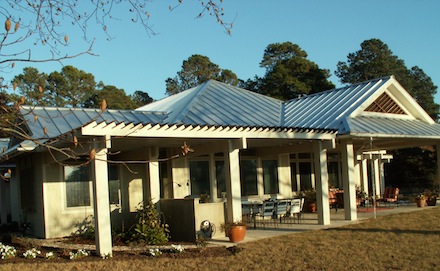House Near Cape Charles LEEDS Way in Energy Efficiency

Holly Dale Drive home rests on the footprint of an earlier house, resulting in minimum disruption to landscape.
Special to the
Cape Charles Wave
December 12, 2012
A new home just south of the Town of Cape Charles has been certified as the most energy-efficient dwelling on Virginia’s Eastern Shore.
The 3,500-square-foot residence on Holly Dale Drive is on a 15-acre lot on Old Plantation Creek. The house has received a Platinum LEED rating (Leadership in Energy and Environmental Design) — the highest rating possible.
The most important strategy to lower energy consumption in the residence was to design the house to work with the climate.
Orientation, massing, shading, natural ventilation, insulation and highly efficient windows are all crucial elements to the design. Every effort was made to maximize the efficiency of these factors before using energy to make the house comfortable.
Designer Janet Harrison of Annapolis was also the green consultant for the Chesapeake Bay Foundation’s Merrill Center — also a LEED Platinum recipient.
The contractor was Luke Kellam of Belle Haven. “The location provided an opportunity to design and build a home that enhances the natural surroundings and captures the expansive views,” said Kellam. “We made every effort to preserve the tranquil setting with a minimal footprint on the property.”
CONTINUED FROM FIRST PAGE
The mechanical equipment is highly energy-efficient. A geo-thermal heat pump takes advantage of the stable temperature of groundwater that is used to heat and cool the house. In the summer, it uses water in the 50s instead of air in the 80s to cool the house, and the excess heat is reused to heat water for showers.
Radiant floors allow the thermostat to be set at a lower temperature. The pergola surrounding the house has blades placed to capitalize on winter sun, while preventing the summer sun’s higher rays from penetrating the structure.
More than 80 percent of the lighting is energy-efficient, fluorescent, LED or Energy Star-certified. In addition, a 5.7 kilowatt array of photovoltaic panels produces solar energy. The panels are connected to a grid so they feed energy into the grid when producing more than the home is using.
“To the extent possible, we used local products in our construction materials,” said Kellam. “Local products require less transportation and reduce both fuel use and emissions. And, they support the local economy.”
Local lumber was used for wall framing, local gypboard was used for all interior drywall, and local concrete and aggregate were used for the foundation, floor and patio. All lumber scraps were recycled into mulch at Maplewood Gardens in Nassawadox.
Recycled materials were also used to divert materials from the waste stream. Those materials include 95-percent-recycled drywall, galvalume roofing made from recycled steel, insulation made from shredded newspapers, and countertops made from recycled mirrors, aluminum, and shredded currency.
Rapidly renewable natural materials such as bamboo, cork and linoleum were used for flooring. The exterior is James Hardie siding, which is engineered to protect the house from harsh climate and moisture.
The site was previously developed, so the new house was built on top of the old footprint to minimize disturbance of the land. The existing driveway was reused.
The majority of the site remains in its natural state. Where the site was disturbed during construction, it was replanted with native grasses that need no watering.
There are a few planting beds close to the house, which are irrigated with a low water drip system supplied by rainwater. All rainwater is collected in a cistern, which reduces water use as well as runoff to the Chesapeake Bay.
“A lot of people assume that green building is prohibitively expensive,” Kellam said. “What we learned is that through careful planning and a very knowledgeable project team, it can be accomplished without pushing budgets beyond reach. Also, some of the energy-efficient systems qualify for tax credits.”
LEED is a voluntary program that provides third-party verification of green buildings. LEED projects have been successfully established in 135 countries. Certified buildings are designed to lower operating costs, increase asset value, reduce waste, conserve energy and water, reduce harmful greenhouse gas emissions, and are healthier and safer for occupants. These properties qualify for tax rebates, zoning allowances and other incentives in hundreds of cities.




















Um, have we factored in the energy required to recycle all the materials? Also, what is the cost constructed sans “LEED” cert, and what was the LEED Cert cost? It would be nice to know what the difference is, and to be able to fully calculate the amortization of all the LEED without tax credits or subsidies (solar array).
Every single thing that was recycled had an energy cost. If we do not know them, the TRUE cost is hidden.